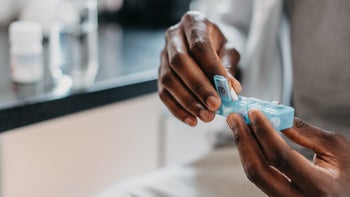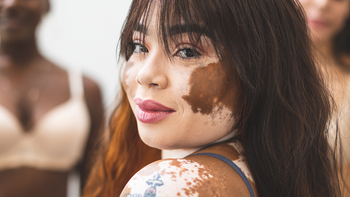
Vitiligo on Fair Skin: How to Tell If You Have This Common Condition (With Pictures)
Key takeaways:
Vitiligo is a common condition that causes patches of skin to lose their color and turn white. The size and number of white patches will vary from person to person.
In fair skin, vitiligo can be harder to spot because there isn’t as much contrast with surrounding skin.
Treatment for vitiligo is similar for people of all skin tones. Treatment depends on how much skin is affected, where the affected skin is, and how much it bothers you.

Vitiligo is a chronic condition that causes white patches on the skin. In people with darker skin tones, vitiligo is usually pretty easy to spot. But it can be more subtle in people with lighter or fair skin tones. To make it even more challenging, there are other common conditions that cause white spots and can be mistaken for vitiligo.
Here, we’ll review what you need to know about vitiligo on white skin, including what it looks like, other conditions that can mimic it, and the best way to treat it.
What is vitiligo?
Vitiligo causes patches of skin to lose their color and eventually turn white. Scientists aren’t exactly sure what causes vitiligo.
Some experts think vitiligo may be caused by an autoimmune condition that affects melanocytes. Melanocytes are special skin cells that make melanin, the pigment that gives your skin and hair their color. In vitiligo, your immune system attacks melanocytes so they can’t produce melanin. This causes skin and hair to lose their natural color and turn white.
Symptoms of vitiligo
When you have vitiligo, white patches can appear anywhere on your skin. And there aren’t usually any other symptoms. The number and size of patches and how much total skin is affected varies from person to person.
Here are some common patterns of vitiligo:
Generalized: This is the most common type. Multiple patches can appear on the face and body, usually in a symmetric pattern (affecting the same area on both sides of the body).
Localized: A few patches develop in one or a few places on the body.
Universal: This is an uncommon type that involves most of the skin.
Segmental: This is the least common type that affects only one side of the body.
The best vitiligo treatments: From creams, pills, and light therapy, find out which vitiligo treatments work best.
Living with vitiligo: Read how one woman went from hiding to helping others with vitiligo.
Is there a cure for vitiligo? No. But, these treatments can restore lost skin color and keep new patches from forming.
What does vitiligo look like in people with fair skin?
Vitiligo causes milky-white patches that are different sizes and shapes. As the patches grow, they can sometimes appear pinkish-white.
Vitiligo is hard to see in people with fair skin because there isn’t as much contrast with the surrounding skin. Vitiligo skin doesn’t tan (in fact, it burns easily). So, it may be easiest to see in the summer as healthy surrounding skin tans. Here are some pictures of vitiligo on white skin.




What can be mistaken for vitiligo?
Other skin conditions can cause white patches on the skin and be mistaken for vitiligo. You may have to see a dermatologist to know which one you have. They can often make the diagnosis by examining your skin and using a special handheld light called a Wood’s lamp. Sometimes, a skin biopsy is needed to make the diagnosis.
Here are some common conditions that look like vitiligo.
Pityriasis alba
Pityriasis alba causes lighter patches of skin, usually on the face, chest, or arms in children and teenagers. It’s more common in people with eczema. Unlike vitiligo, the patches of pityriasis alba still contain some color pigment and don’t have sharp borders.

Idiopathic guttate hypomelanosis
Idiopathic guttate hypomelanosis (IGH) causes multiple small, round, white spots, usually on the arms and legs. The cause of IGH isn’t known. But it may run in families and be related to sun exposure.

Tinea versicolor
Tinea versicolor is a fungal infection that causes light-colored patches, usually on the face, upper back, chest, and upper arms. Unlike vitiligo, it can be itchy, and it’s usually scaly — not smooth.

Post-inflammatory hypopigmentation
Post-inflammatory hypopigmentation is white spots that develop after skin inflammation heals. This can happen after a skin injury (like a scrape) or a rash (like acne) heals. We’re not sure why it happens. But the inflammation seems to change the level of melanin pigment in the skin.

How do you treat vitiligo on fair skin?
The treatment options for vitiligo are the same for all skin tones. There’s no cure, but treatments can help stop vitiligo from spreading and help your skin regain its natural color. Deciding which treatment is right for you depends on many things, including how much the vitiligo bothers you, how much skin is involved, and where you have it.
It’s common to combine treatments and change treatments if they don’t work well. Here are the main treatment options for vitiligo:
Medicated creams: First-choice treatments usually include Opzelura (an FDA-approved JAK inhibitor) and corticosteroids (like betamethasone). Other options include calcineurin inhibitors, like tacrolimus (Protopic), and vitamin D creams, like calcipotriene (Dovonex).
Light therapy (phototherapy): Ultraviolet light is delivered to the skin in a controlled setting. This is usually done in your doctor’s office.
Systemic treatments: For more severe vitiligo, these are stronger medications given as pills. They’re more likely to have more side effects. Examples include prednisone and methotrexate.
Surgery: There are different types of surgery. They usually involve removing small pieces of unaffected skin and putting them into vitiligo patches. This can be an option when other treatments don’t work.
Sunscreen: Daily sunscreen is a must if you have vitiligo. This protects your skin from sunburn, which can make vitiligo worse and increase your risk of skin cancer.
Many people with vitiligo also use camouflage creams. They come in different shades and blend in with unaffected skin. They don’t treat vitiligo, but they can reduce feelings of self-consciousness and improve quality of life for some. If you want ideas for vitiligo camouflage products, take a look at what has worked for some people with vitiligo.
Frequently asked questions
Yes, vitiligo can be genetic, but it isn’t always. About 2 in 10 people with vitiligo will have a close family member who also has it.
Vitiligo can affect anyone at any age, but it usually appears before the age of 20. It’s also more common in people who have other autoimmune diseases, like:
Pernicious anemia
Thyroid disease
Addison’s disease
People with vitiligo may have low levels of different vitamins, like vitamin D or B12. But this doesn’t mean that these deficiencies cause their vitiligo. One study showed that people with low vitamin D levels had more active vitiligo than those with normal levels. But more research is needed to understand the relationship between vitamin D and vitiligo.
Yes. People with vitiligo may also experience some of these health conditions:
Eye problems (like night blindness)
Hearing loss
The bottom line
Vitiligo is a common skin condition that causes white spots to develop on the skin. It can be harder to spot vitiligo in fair skin because there isn’t as much contrast with the surrounding skin. Other skin conditions that cause white patches, like tinea versicolor and pityriasis alba, can be mistaken for vitiligo. Before starting treatment, it’s important to get the right diagnosis.
Treating vitiligo in fair skin includes medicated creams, pills that work throughout the body, and light therapy. Wearing sunscreen is also a must to protect your skin from sunburn.
Why trust our experts?



Images used with permission from VisualDx (www.visualdx.com).
References
Albert, D. M., et al. (1983). Vitiligo and disorders of the retinal pigment epithelium. British Journal of Ophthalmology.
American Academy of Dermatology Association. (2022). Vitiligo: Overview.
American Academy of Dermatology Association. (2022). Vitiligo: Signs and symptoms.
American Osteopathic College of Dermatology. (n.d.). Biopsy.
American Osteopathic College of Dermatology. (n.d.). Idiopathic guttate hypomelanosis.
Colucci, R., et al. (2020). Evidence of a possible therapeutic role of vitamin D in a cohort of adult Caucasian vitiligo patients. International Journal for Vitamin and Nutrition Research.
Harris, J. E. (2016). Should I change my diet or take supplements for my vitiligo? University of Massachusetts Chan Medical School.
Hurrell, A. (2023). Our community nominate their top 3 cosmetic camouflage products for vitiligo skin. The Vitiligo Society.
Jan, N. A., et al. (2023). Vitiligo. StatPearls.
Ludmann, P. (2023). Vitiligo: Diagnosis and treatment. American Academy of Dermatology Association.
MedlinePlus. (2022). Vitiligo.
National Institute of Arthritis and Musculoskeletal and Skin Diseases. (2022). Vitiligo.
Ongenae, K., et al. (2005). Quality of life and stigmatization profile in a cohort of vitiligo patients and effect of the use of camouflage. Dermatology.
Stefanska, K. (2023). Everything you need to know about the use of phototherapy for treating vitiligo. The Vitiligo Society.






